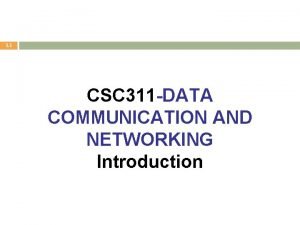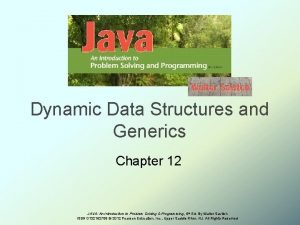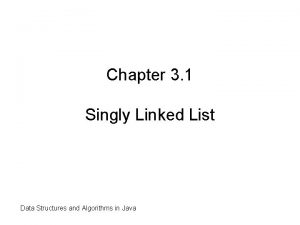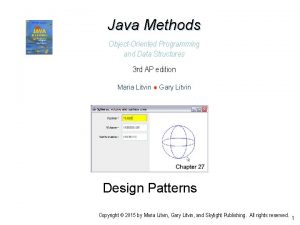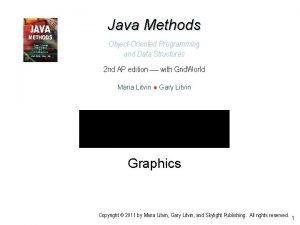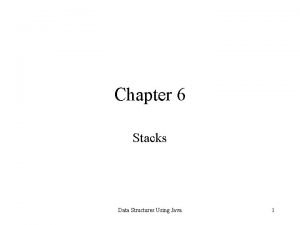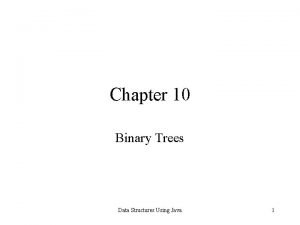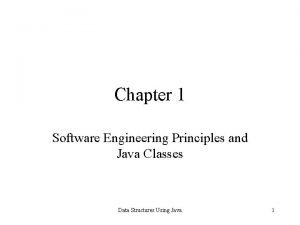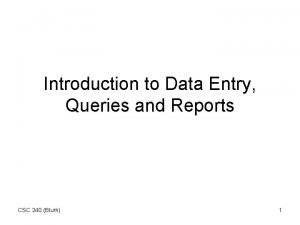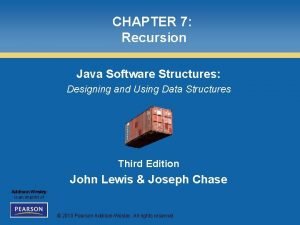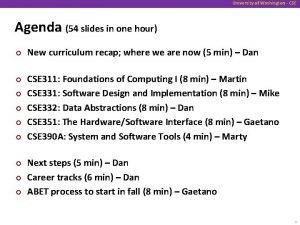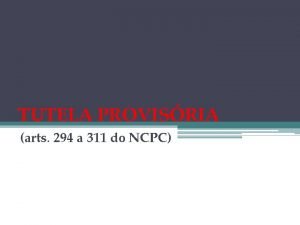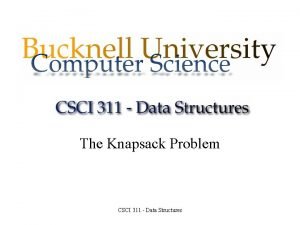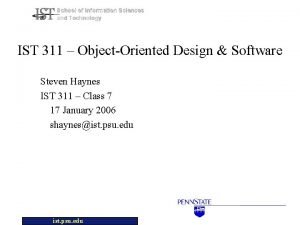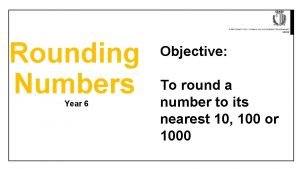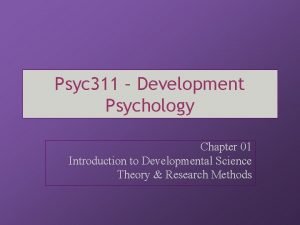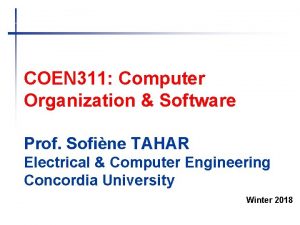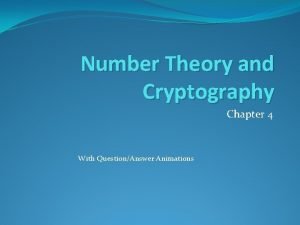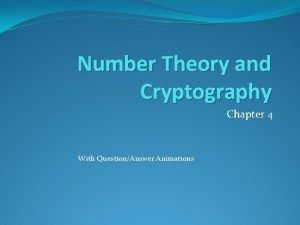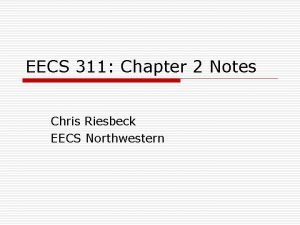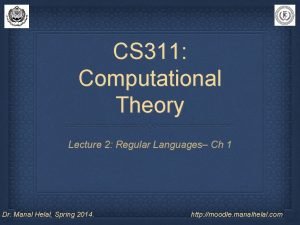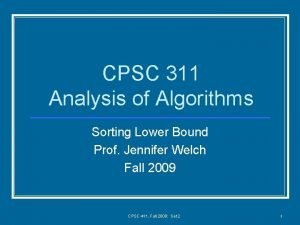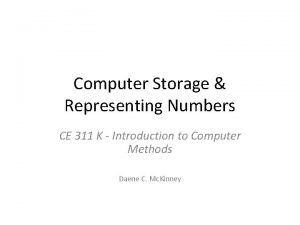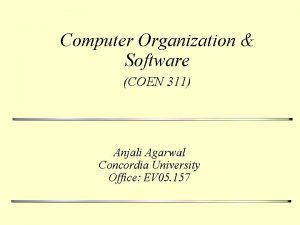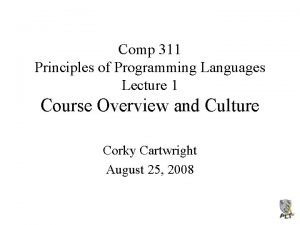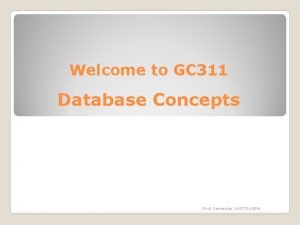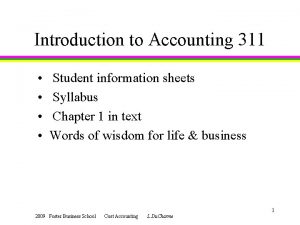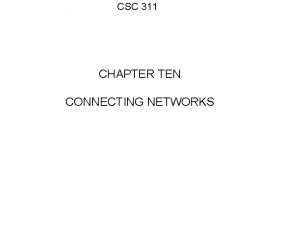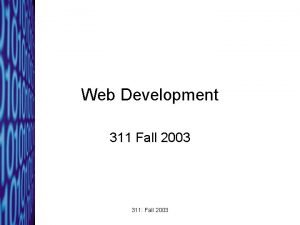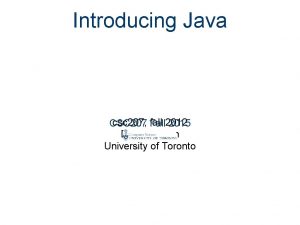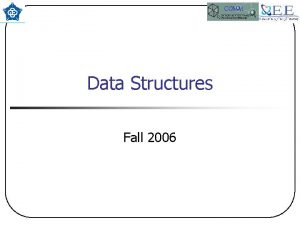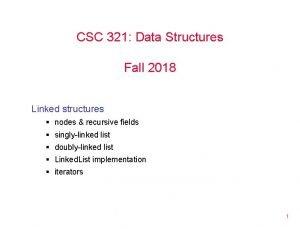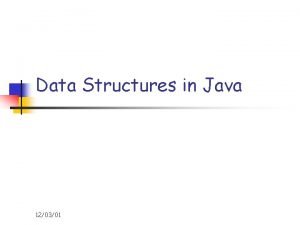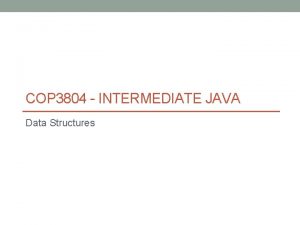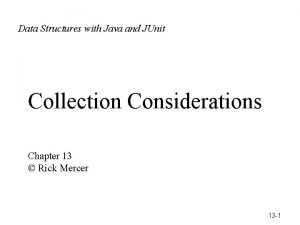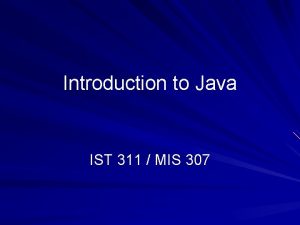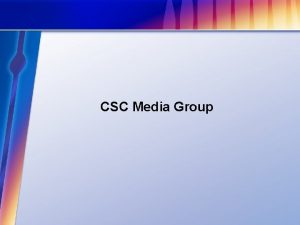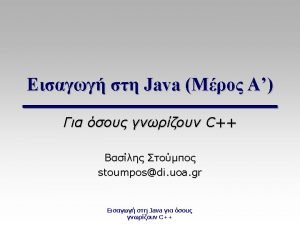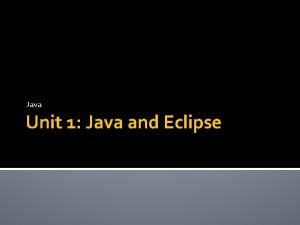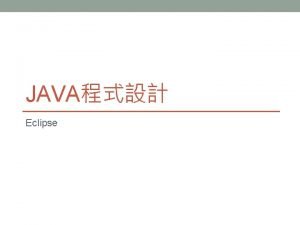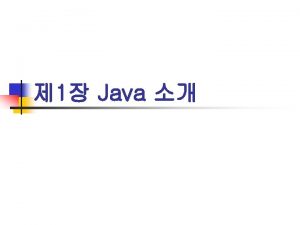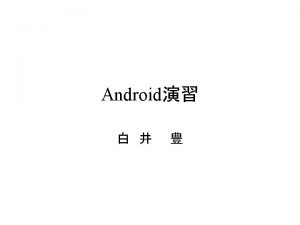CSC 311 Data Structures Java Review Fall 2006
































- Slides: 32

CSC 311: Data Structures Java Review Fall 2006 CSC 311: Data Structures 1

The Java Virtual Machine (JVM) Virtual machine -- the logical machine (nonphysical machine) that performs machine functions, typically implemented in software on top of a "real" hardware platform and operating system JVM -- the software implementation of a "CPU" designed to run compiled Java code Includes stand-alone Java applications, as well as "applets" that are downloaded and run in Web browsers such as the Net. Scape Navigator Thanks to the JVM, programs written in Java don't have to be rewritten to run on different computers Need an interpreter to translate JVM code to machine code Fall 2006 CSC 311: Data Structures 2

Class and Object What is a class? – – A class is corresponding to a concept, e. g. People, Student, Faculty, Staff, Rectangle, Circle, etc In Java, a class is a set of objects with the same behavior What is an object? – – Fall 2006 An object is corresponding an entity, e. g. Jack, Peter In Java, an object is an entity that you can manipulate in your programs (by invoking methods) Each object belongs to a class Object constructions CSC 311: Data Structures 3

Class Components – Fields – name, type and specifier – Methods – signature (prototype) – Constructors – object initialization Declaration – – – Fall 2006 Variable declaration Object variables w/o initialization Method declaration // method calls CSC 311: Data Structures 4

Data Types Data types – Primitive data types – int, long, short, double, float, boolean, char – Classes – String, Object Type conversion – Explicit type conversion – casting may cause information lost – Implicit type conversion – default no information lost Fall 2006 CSC 311: Data Structures 5

Casting and Autoboxing/Unboxing Casting: (type) expr Autoboxing – – – Implicit casting Number – Integer, Double, Float, etc Anytime a Number object is expected as a parameter to a method, the corresponding base type can be passed: Number base type Unboxing – Fall 2006 Anytime a base type is expected in an expression involving a Number reference, that Number object is changed to the corresponding base type Number CSC 311: Data Structures 6

Enum Types Declaration modifier enum name {vale_name 0, value_name 1, …, value_namen-1 Example Public enum Day{Mon, Tue, Wed, Thu, Fri, Sat, Sun}; Constants -- final Fall 2006 CSC 311: Data Structures 7

Statements Assignments – location Decisions – – – If-then-else Switch-case – – – while do-while for – – – break continue return Iterations Restricted gotos Boolean expressions and short-circuit evaluation Fall 2006 CSC 311: Data Structures 8

Simple Input and Output Simple output methods: – Built-in static object: System. out – – print(Object) Print(String) print(base_type) Println(String) – – – Built-in special object: System. in Related class: java. util. Scanner sc = new Scanner(System. in); has. Next() next() has. Next. Type() next. Type() has. Next. Line() next. Line() find. In. Line(String) An instance of java. io. Print. Stream class Simple input methods Fall 2006 CSC 311: Data Structures 9

Designing classes Choosing classes – – A class represents a single concept Concepts from mathematics: Point, Rectangle, Ellipse Concepts from real life: Bank. Account, Person, Student Utility classes--no objects, only static methods Math Principles: – – – Fall 2006 Responsibilities Independence Behaviors CSC 311: Data Structures 10

Designing classes Cohesion and Coupling – – Cohesive: all methods are closely related to the single concept that the class represents Coupling: A class depends on another if it calls one of its methods High Coupling many class dependencies Minimize coupling to minimize the impact of interface changes Fall 2006 CSC 311: Data Structures 11

Accessor and Mutator Classes Accessor: does not change the state of the implicit parameter (e. g. get. Balance()) Mutator: changes the state of the implicit parameter (e. g. deposit(double amount ) Rule of thumb: Mutator should return void Immutable class: all methods are accessors (e. g. String) Fall 2006 CSC 311: Data Structures 12

Preconditions/postconditions Precondition – The condition that must be met before the method executes – Publish preconditions so the caller won't call methods with bad parameters Postcondition – The condition that's true after a method has completed – If not, the method functioned incorrectly Fall 2006 CSC 311: Data Structures 13

Scope of variable: region of program where the variable can be referred by its name – Local variable scope: from definition to end of block – Class scope: all methods of the class – Overlapping scope: local scope wins over class scope Static scope – Static fields Define a field that belongs to a class instead of any object Non-static fields are instance fields, while static fields are class fields Minimize the use of static fields – Static methods No implicit parameter Too many static methods are a sign of too little Object-oriented Fall 2006 CSC 311: Data Structures 14

Coding and Pseudo-code Coding – programming in Java – IDE Pseudo-code – Mixes natural language with standard programming language constructs – Constructs: Expressions Method declarations Decision structures Loop structures Array indexing Method calls Method returns comments Fall 2006 CSC 311: Data Structures 15

Object-oriented Design Goals – Robustness – Adaptability – Reusability Principles – – – Abstraction Encapsulation Modularity Design Patterns – Describe a solution to a typical software design problem – Some typical design patterns: Position, Adaptor, Iterator, Template method, Composition, Comparator, Amortization, Divide-and-conquer, etc. Fall 2006 CSC 311: Data Structures 16

Inheritance Specialization and generalization (extension) – Specialization – subclass – Generalization -- superclass Method overriding – Refinement – Replacement The keyword this Fall 2006 CSC 311: Data Structures 17

Inheritance Hierarchies of classes, subclasses, and subsubclasses are common Similar to concept hierarchies: – Person has subclasses like Faculty, Student, Staff; – Faculty may have subclasses Full. Time. Faculty and Part. Time. Faculty; – Full. Time. Faculty may have Tenured. Faculty and Tenure. Track. Faculty; – Student may have subclasses Full. Time. Student and Part. Time. Student; – etc. A superclass can have multiple subclasses, but a subclass should have at most ONE superclass Fall 2006 CSC 311: Data Structures 18

Inheritance of Methods Override method: Supply a different implementation of a method that exists in the superclass Inherit method: Don't supply a new implementation of a method that exists in the superclass Add method: Supply a new method that doesn't exist in the superclass Subclass can not access the private methods of superclass Calling a Superclass Method/constructor Fall 2006 CSC 311: Data Structures 19

Inheritance of Fields Inherit field: All fields from the superclass are automatically inherited Add field: Supply a new field that doesn't exist in the superclass Can't override fields Subclass can not access the private fields of superclass Fall 2006 CSC 311: Data Structures 20

Polymorphism (greek: many shapes): The type of the object determines the method to call Called late binding. Resolved at runtime Different from overloading. Overloading is resolved by the compiler Converting from subclasses to superclass The instanceof method – Test whether an object is of a specified class – Example: x instanceof String to test if x is a string Fall 2006 CSC 311: Data Structures 21

Access control public – accessible anywhere private – accessible inside the class protected -- accessible by class, subclasses and package default – no specifier, accessible by package Recommended Access Levels – Fields: Always private Exception: public static final constants – Methods: public or private – Classes: public or package – Don't use protected – Beware of accidental package access (forgetting public or private) Fall 2006 CSC 311: Data Structures 22

The Object The Cosmic Superclass All classes extend Object by default Most useful methods: – String to. String(): to convert the object to a string message – boolean equals(Object other. Object): to test if the object is equal to the given object other. Object – Object clone(): to create a new copy of the object Fall 2006 CSC 311: Data Structures 23

Exceptions Throwing exceptions Catching exceptions – Try-catch-finally block try { … } catch (exception_type 1 catch (exception_type 2 … finally { … } Fall 2006 CSC 311: Data Structures e 1) e 2) { { … … } } 24

Interfaces Special classes All methods in an interface are abstract – no implementation All methods in an interface are automatically public An interface doesn't have instance fields An interface doesn’t have constructors Interface implementation – Should be implemented by classes Multiple inheritance in Interfaces Fall 2006 CSC 311: Data Structures 25

Abstract Class and Method Abstract class – – – Cannot have direct instances (objects) Must be extended by subclass(es) Can implement some methods (main difference from interfaces) Abstract method – Must be overridden by subclass(es) – Must be inside abstract classes – Non-abstract class cannot have abstract method Fall 2006 CSC 311: Data Structures 26

Strong Typing Strong typing – All variables must be typed Java – A strong-typing language – An object can be viewed as being of various types – But declared as being of only one type Fall 2006 CSC 311: Data Structures 27

Generics Casting – Widening conversion: to superclass – Narrowing conversion: to subclass – Casting exception – Casting with interfaces Generics – Generic type: a type that is not defined at compilation time, but becomes fully specified at run time – Formal type parameters – Actual type parameters Fall 2006 CSC 311: Data Structures 28

Generics: Example public class Pair<K, V> { K key; V value; public void set(K k, V v) { key = k; value = v; } public K get. Key() { return key; } public V get. Value() { return value; } } Public static void main(String[] args) { Pair<String, integer> pair 1 = new Pair<String, Integer>(); pair 1. set(new String(“height”), new Integer(36)); Pair<String, Double> pair 2 = new Pair<String, Double>(); pair 2. set(new Student(“A 5678”, “Sue”, 19), new Double(9. 5)); } } Fall 2006 CSC 311: Data Structures 29

Arrays A set of data cells with fixed size, each cell holding a data item and all data items being the same type Purpose: to construct a linear structure to hold a given number of elements. Once an array is created, its size is fixed – length Indices starting from 0 Common algorithms on arrays – Find max/min values – Find average value – Linear search Copying array and clone array High-dimensional arrays Fall 2006 CSC 311: Data Structures 30

Array List Array. List is a class – data type Purpose: to construct a linear structure to hold a flexible number of elements Methods: – size() – returns the number of elements in the Array. List: a. size() – get(<index>) – returns the <index>-th element that is the type of Object should convert the return value to your specific type The <index> starts at 0 – set(<index>, <object>) – sets the <index>-th element to <object>, overwrites the old element – add(<index>, <object>) – adds <object> before the <index>-th element – remove(<index<) – removes the <index>-th element Fall 2006 CSC 311: Data Structures 31

Recursion A recursive computation solves a problem by using the solution of the same problem with simpler input For recursion to terminate, there must be special cases for the simplest inputs The simplest case can be directly solved The recursive cases should call the method itself Fall 2006 CSC 311: Data Structures 32
 Network criteria in data communication
Network criteria in data communication Advanced data structures in java
Advanced data structures in java Linked list java
Linked list java Data structures and abstractions with java
Data structures and abstractions with java Java data structures
Java data structures Data structures in java
Data structures in java Data structures in java
Data structures in java Data structures using java
Data structures using java Data structures using java
Data structures using java Data structures using java
Data structures using java Example of homologous structure
Example of homologous structure Csc data entry
Csc data entry Java software structures 4th edition
Java software structures 4th edition Cse 332 uw
Cse 332 uw Art 294 a 311 novo cpc
Art 294 a 311 novo cpc Csci 311
Csci 311 Ist 311
Ist 311 311 rounded to the nearest ten
311 rounded to the nearest ten Psyc 311
Psyc 311 Rtca do-311a
Rtca do-311a Rpv311
Rpv311 Coen311
Coen311 Find an inverse of 101 modulo 4620
Find an inverse of 101 modulo 4620 The number 311-38 is divisible by prime numbers:
The number 311-38 is divisible by prime numbers: Ssis 311
Ssis 311 Eecs 311
Eecs 311 Cs 311
Cs 311 Cpsc 311
Cpsc 311 311 k
311 k Anjali agarwal concordia
Anjali agarwal concordia Comp 311 textbook notes
Comp 311 textbook notes Gc 311
Gc 311 Accounting 311
Accounting 311
